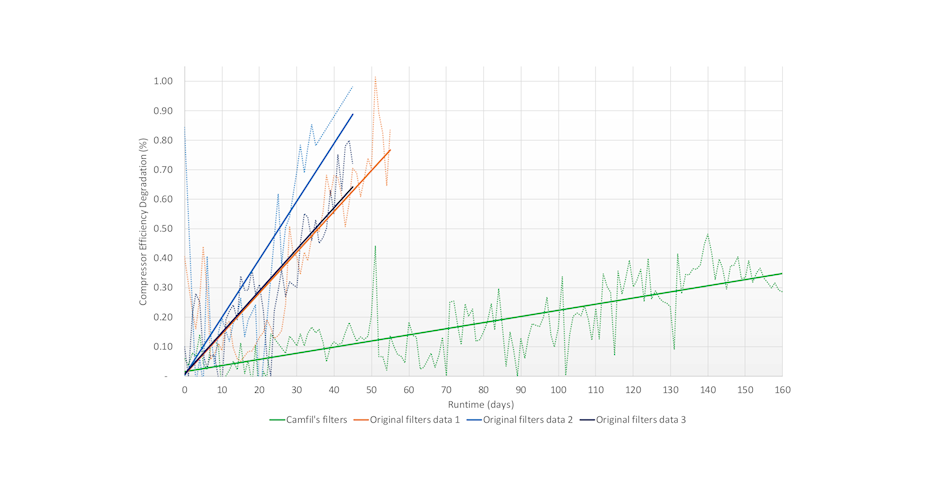CK Power in Thailand Improves Gas Turbine Compressor Efficiency Degradation & Reduces Gas Turbine Maintenance Requirements

BIC1 consists of two gas turbines with a total capacity of 117.5 MW. It is located in the coastal area of the Gulf of Thailand, in the Bangpa-in industrial district in Ayutthaya, close to the capital of the country, Bangkok. Air pollution is a prominent problem in the area.
In this area, the gas turbines are exposed to high concentrations of contaminants. For example, the annual average PM2.5 level in Ayutthaya was 25 μg/m3 1, which was more than double the recommended annual average by the WHO (10 μg/m3)2. Fine dust, if ingested in the gas turbines, can cause fouling, erosion and plugging of cooling passes.
Ayutthaya has a high annual average relative humidity of 73%3. The humidity in air can combine with dust to form sticky dust, which is challenging for filtration.
BIC1 faced challenges in terms of both compressor efficiency loss and the availability of the gas turbines:
• The prefilters required 8 online filter replacements per year.
• The final filters required 4 offline filter replacements per year.
• Significant compressor efficiency loss required at least 4 offline washes per year.
The high level of maintenance associated with the filters adversely affected the availability of the gas turbines. Moreover, the short filter life entailed a high inventory cost. Therefore, BIC1 opened a bid for an upgraded filtration system.
The original filtration configuration of BIC1 was the following 2-stage filter system consisting of:
• 1st stage: G4 panel pre-filters (filter life: 1-2 months)
• 2nd stage: F9 cartridge final filters (filter life: 3 months)

B1C1 set the following bid requirements:
• Reduction in compressor efficiency degradation
• Both pre-filters and final filters last at least 1 year
Camfil performed a life-cycle cost analysis (LCC) to compare different filter configurations in order to determine the optimal solution. Based on the analysis, Camfil recommended to retrofit the system from a cartridge to a static configuration, with a 2-stage EPA class system:
• 1st stage: Hi-Flo XLT F7 bag pre-filters. (EN779:2012)
• 2nd stage: Cam GT 4V-300 E10 compact final filters (EN1822:2019).
• Figure 1 shows compressor efficiency degradation for the original filter versus the Camfil filters. Three lines are shown for the original installation; a filter replacement was required at the end of each line. Overall results show that compressor efficiency degradation was increasing at a rate 6 times faster on average with the original filters than with the upgraded Camfil filters.
• With a higher rate of compressor degradation, more offline water washes are required to recover efficiency. The previous configuration required 4 offline washes annually, while Camfil’s solution required only 1 offline wash, during a scheduled outage.
• The final filters require only 1 offline filter replacement instead of 4, during the plant’s annual outage.
• The pre-filters require only 1 filter change instead of 8, during the plant’s annual outage.
Camfil‘s life-cycle cost analysis showed that BIC1‘s investments would result in savings of $150 000 USD per gas turbine, per year, with the Camfil installation. These savings are mainly due to the significant reduction in filter inventory and the maintenance frequency.
1. Average PM2.5 level in Ayutthaya, 2019: Real-time Air Quality Index: https://aqicn.org/city/thailand/ayutthaya/ayutthaya-witthayalai-school/
2. Ambient (outdoor) air pollution, WHO: https://www.who.int/news-room/fact-sheets/detail/ambient-(outdoor)-air-quality-and-health
3. Ayutthaya Monthly Climate Averages, Weather and Climate: https://weather-and-climate.com/average-monthly-Humidity-perc,phra-nakhon-si-ayutthaya,Thailand
According to The Value Rating classification system, Table 1 shows the CamGT 4V-300 E10 increases power output by 4.7%, decreases fuel penalty by 2.4% MJ/MWh, and increases the CO2 savings by 9 600 tonnes/TWh, as compared to the original F9 final filter.
These results are based on a standardized environment that are already assumed in The Value Rating calculations. This is a tool that operators can use when a more detailed Life Cycle Cost analysis has not been performed. It is a good indicator to compare filters.
| Competitor F9 | CamGT 4V-300 E10 | |
| Power output | 93.7% | 98.4% |
| Fuel penalty | +3.1% MJ/MWh | +0.7% MJ/MWh |
| CO2 savings | 6 700 tonnes/TWh | 16 300 tonnes/TWh |




Hi-Flo XLT F7 bag pre-filter
CamGT 4V-300 E10 compact final filter